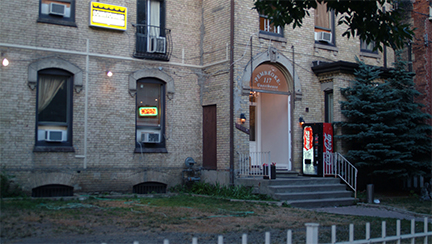
Pembrooke Avenue, the street location of the woman's homeless shelter where the subject lived in 2003 or thereabouts.
Jennifer Pallister entered the program at the Gender Clinic at the Centre for Addiction & Mental Health (CAMH) (then called the Clarke Institute of Psychiatry) in 1994 or thereabouts. Pallister reported she felt female and reported telling the CAMH that. Pallister also reported she suffered from a multitude of mental disorders, including borderline personality disorder, a depressive mood disorder and attention deficit disorder.
Pallister reported that she engaged in heterosexual relations prior to transition. Pallister regarded herself as being an attractive male with 'soft' features. She reported she had a number of 'hot' girlfriends. She said in the case of one woman that she not only wanted to have intercourse with this woman, but also she wanted to look like her. She also reported that she had engaged in cross-gender roles where the women penetrated Pallister's vagina with her penis.
Pallister met Shadmith Manzo and her partner, Crystal, at the Gender Clinic. Manzo was at the time a pre-operative self-identifying lesbian transsexual. From meeting the lesbian couple, Pallister identified with the lesbian lifestyle where one partner was a transsexual woman and the other a born female. Manzo's working relationship validated to her that being involved with a born female was possible as a transsexual woman.
Prior to surgery Pallister's career was arguably erractic. She cycled between having full time employment and being unemployed for significant stretchs of time (one to two years). Pallister eventually found work at Delrina, a software company. At Delrina Pallister worked as a software engineer on printer drivers, user interface controls, and on its aware winning product, WinFax (as reported by Pallister). Delrina sold millions of licenses of WinFax, embedded with Pallister's code. If Pallister's software didn't work, which happened at times, the company lost in her words, "thousands and thousands" of dollars per day.
Pallister reported she began to transition at work in September, 1994. She reported going to work in women clothing, including blouses and skirts. She also wore a wig to hide a receeding hairline. She reported she felt enormous freedom doing so. Pallister recalls that people were generally supportive at work. They complimented her on how good she looked as a woman. One individual in fact, said she looked better as a woman than as a man.
Unfortunately, Pallister's energies were focused more on her transition than work. Pallister reported that her productivity declined. She was no longer effective at her job. The company no doubt began to question the quality of Pallister's work. In November, 1994, Delrina dismissed Pallister. Pallister did not engage is any grievance or complain of wrongful dismissal against Delrina for dismissing her.
Pallister reported that CAMH (formerly the Clarke Institute) referred Pallister to Betty Chan, M.D., an endrochronologist, to obtain hormones. Pallister stopped seeing Chan, who she didn't like, and sought out the care of Dr. John Goodhew, a general practioner, who she refered to as a "maniacal prick," for hormone replacement therapy.
By 1998 Pallister had been living as a woman for several years. Pallister, who grew impatient with CAMH, obtained a number of letters to the effect that she was a bonafide candidate for SRS from the psychiatrists she knew from her experience and engaged Dr. Eugene Schrang, M.D. in Leeham, Wisconsin, to perform sexual reassignment surgery on her. Pallister reported having the first stage of sexual reassignment surgery by Dr. Schrang, M.D. in Leeham, Wisconsin, in June, 1998 and the second stage on November 2, 1998, a few months later.
After returning from Neeham, Wisconsin, Pallister appied for and received long term disability benefits from the Workplace Safety and Insurance Board (WSIB) then known as the Workman's Compensation Board (WCB), claiming she had sexual reassignment surgery. Apparently, people who undergo sexual reassignment surgery are entitled to disability benefits in Ontario. Despite having a great resume to draw from, Pallister had difficulty finding a new job to replace her position with Delrina. Ironically, she found work in the community of transsexuals. She worked for a small hardware integration company called [name withheld]. [name withheld], M.D., who was a post-operative transsexual women, herself, owned [name withheld]. [name withheld] and Pallister parted company after only a few months. Pallister had chronic difficulties with employment, since she lost her job with Delrina in 1994.
Pallister reported spending her entire life savings which largely came from the sale of a property, on her transition. She said that after all the procedures she had a debt owing of five thousand dollars on her Visa Account or thereabouts.
Pallister had a limited number of sexual relationships with women as a transsexual women.
Pallister lives on and off at a Women's Shelter in Toronto, Ontario, according to individuals in the community.
The CAMH could see Pallister as a successful transsexual woman. Pallister reportedly never expressed any explicit regrets to the CAMH.
more information
[1] Interview with Jennifer Claire Pallister, a.k.a., Randy Pallister, dated February 8, 2000